[Newsbits] 6.01.2024: PRITHVI Scheme, Alvaro Cyclone, REJUPAVE & more
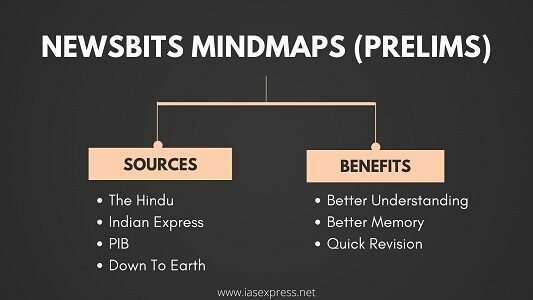
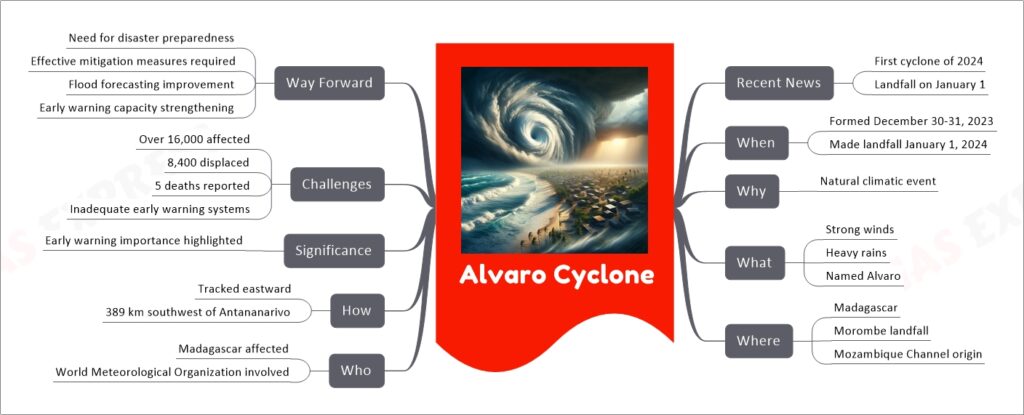
Cyclone Alvaro, the first of 2024, made landfall in Morombe, Madagascar, on January 1. Originating in the Mozambique Channel, it brought strong winds and heavy rain, affecting over 16,000 people, displacing 8,400, and causing at least 5 deaths. Regions like Atsimo-Andrefana, Haute Matsiatra, and Menabe were severely hit. The cyclone highlighted Madagascar’s vulnerability to climate-related disasters and underscored the need for more robust early warning systems and disaster preparedness, particularly in areas prone to flooding and severe weather.
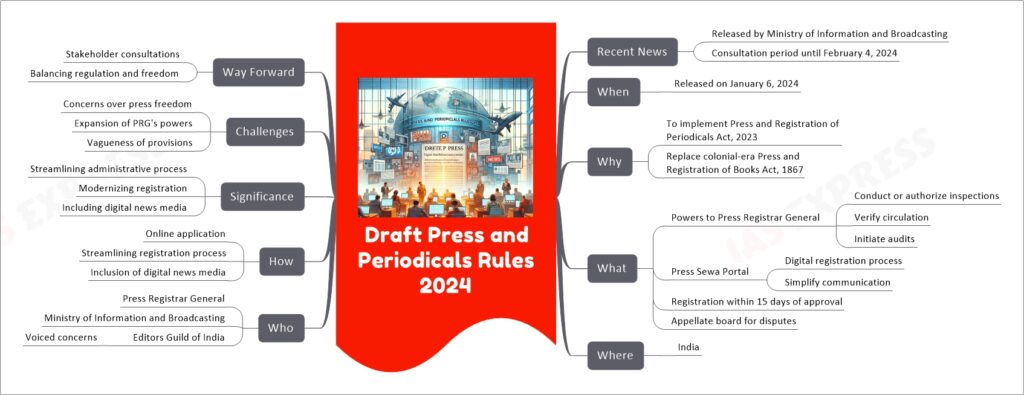
The Draft Press and Periodicals Rules 2024 in India, released by the Ministry of Information and Broadcasting, aim to modernize and streamline the process of registering newspapers and periodicals. Replacing the colonial-era Press and Registration of Books Act of 1867, these rules propose digital registration through the Press Sewa Portal and grant the Press Registrar General authority for inspections and audits, especially under certain circumstances such as irregular circulation reports. These rules have stirred debate over potential implications for press freedom, with concerns raised by the Editors Guild of India about the expansion of the Press Registrar’s powers and the vagueness of some provisions. The introduction of an appellate board for registration disputes is seen as a positive step. The consultation period for these rules is an opportunity for stakeholders to influence the future of press regulation in India.
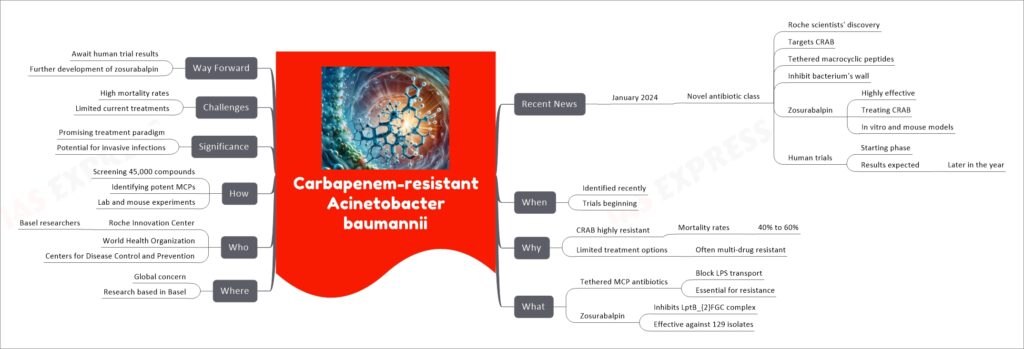
Carbapenem-resistant Acinetobacter baumannii (CRAB) is a highly drug-resistant bacterial pathogen causing nosocomial infections with mortality rates between 40% to 60%. Recently, scientists at Roche have discovered a novel class of tethered macrocyclic peptide (MCP) antibiotics effective against CRAB. These MCPs work by blocking the transport of lipopolysaccharide, crucial for the bacterium’s resistance. The promising antibiotic candidate, zosurabalpin, has shown high efficacy in vitro and in mouse models, with human clinical trials underway. In India, a study highlighted the presence of bla_{OXA-51-like} in all CRAB isolates, with bla_{OXA-23-like} and bla_{NDM-like} being predominant, indicating a potential emerging lineage of carbapenem resistance.
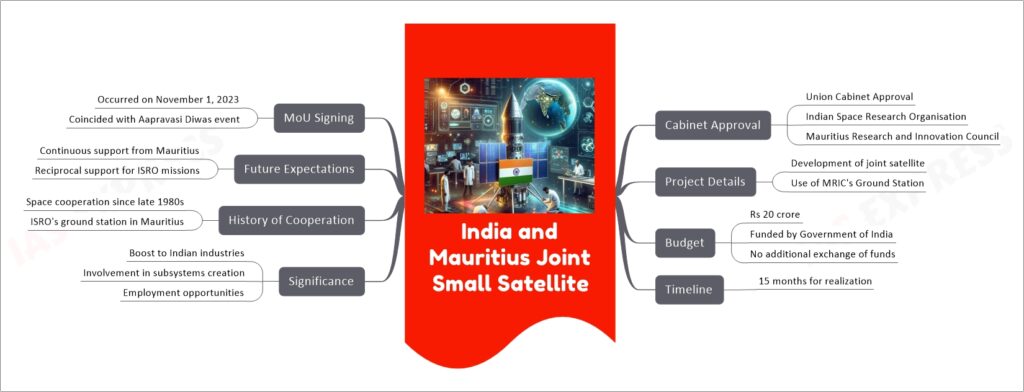
India and Mauritius have embarked on a collaborative venture to develop a joint small satellite, an initiative that was officially sanctioned by India’s Union Cabinet. This endeavor, involving the Indian Space Research Organisation (ISRO) and the Mauritius Research and Innovation Council (MRIC), is not just a singular project but a continuation of a long-standing partnership in space technology that dates back to the late 1980s. The project is budgeted at Rs 20 crore, funded by the Indian government, and is expected to be realized within 15 months. A key aspect of this collaboration is the utilization of MRIC’s Ground Station, which bolsters the project’s capabilities. The partnership is poised to invigorate Indian industries through involvement in subsystem creation, generating employment opportunities and enhancing technical competencies. The signing of the Memorandum of Understanding (MoU) for this project aligns with historical ties and anticipates mutual support for future space missions, reinforcing the strategic and technological bond between India and Mauritius.
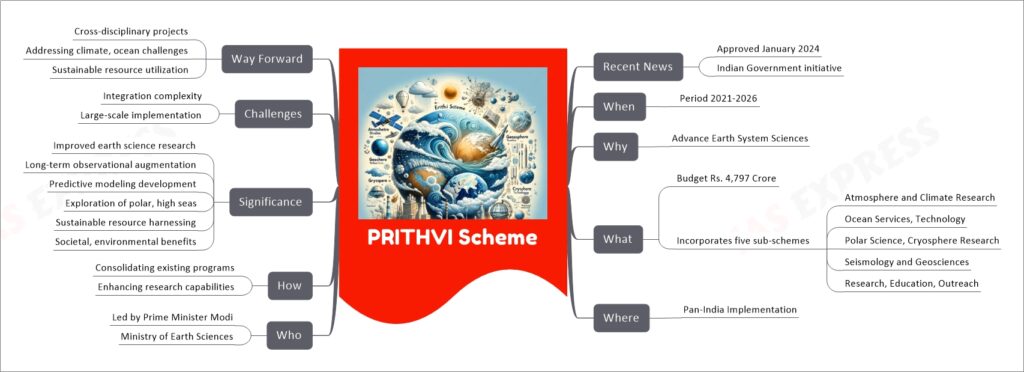
In simple terms, the PRITHVI Scheme is a significant project approved by the Indian government, spearheaded by Prime Minister Narendra Modi, with a budget of Rs. 4,797 crore. Spanning from 2021 to 2026, its aim is to unify and enhance Earth System Sciences research in India. It integrates five existing sub-schemes, focusing on various aspects of earth sciences such as atmospheric and climate research, ocean services, polar science, seismology, and outreach programs. The scheme promises to transform India’s approach to research and practical applications in Earth System Sciences, offering societal, environmental, and economic benefits.
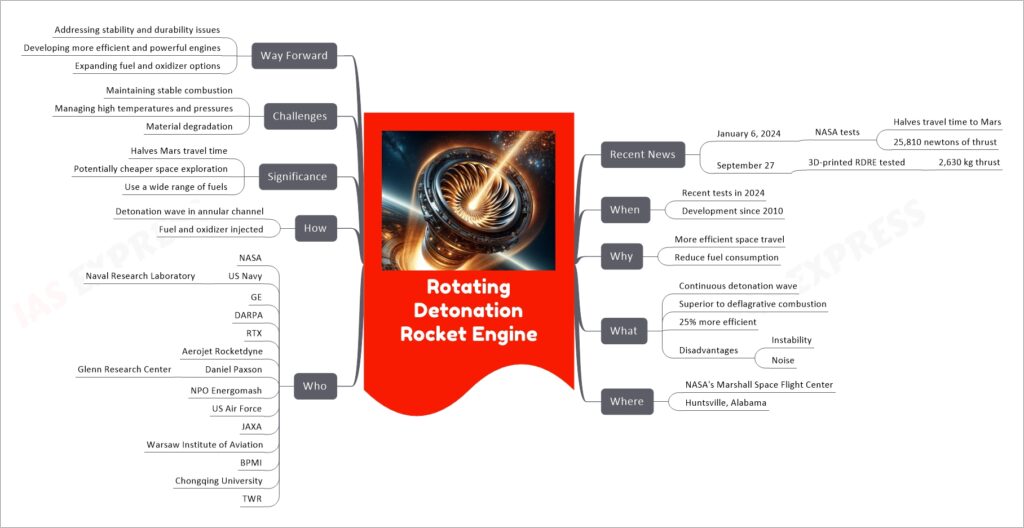
In simple terms, the Rotating Detonation Rocket Engine (RDRE) represents a significant advancement in rocket propulsion technology. Unlike traditional rocket engines that rely on deflagrative combustion, the RDRE uses a continuous detonation wave, making it potentially more efficient and powerful. This technology, still in development, promises to reduce travel time to destinations like Mars, offer more cost-effective space exploration, and use a broader range of fuels. However, it faces challenges like achieving stable combustion over long periods, handling high temperatures and pressures, and preventing material degradation.

The NASA Innovative Advanced Concepts (NIAC) program supports pioneering ideas and early-stage technology concept studies that could revolutionize future NASA missions. This program focuses on innovations from diverse sources, aiming to change what’s possible in aerospace by supporting transformative space technology research. In January 2024, NASA announced 13 innovative concepts selected under this program from various U.S. companies and institutions, with each receiving a maximum grant of $175,000. These concepts range from fixed-wing flight on Mars and a swarm of tiny spacecraft traveling to Proxima Centauri, to a spacecraft designed to survive Venus’ harsh environment and return a sample from its surface. The program, funded by NASA’s Space Technology Mission Directorate, has been instrumental in inspiring successful past missions and continues to push the boundaries of space exploration.
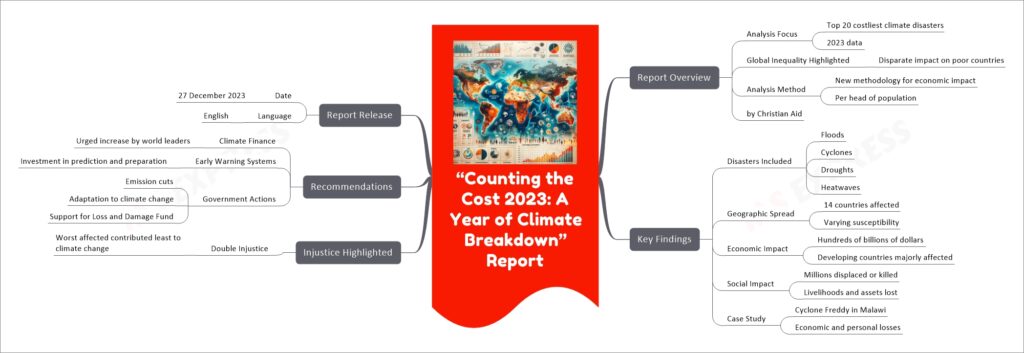
The “Counting the Cost 2023: A Year of Climate Breakdown” report by Christian Aid provides a critical analysis of the economic and human costs of climate-related disasters in 2023. It highlights the unequal impact of these disasters across different countries, with a particular focus on how poorer nations bear a disproportionate burden. The report uses a novel methodology to assess the economic impacts per head of population in the affected countries. It calls for increased climate finance, investment in early warning systems, and urgent action to cut emissions and adapt to climate change, emphasizing the need for a well-resourced loss and damage fund.
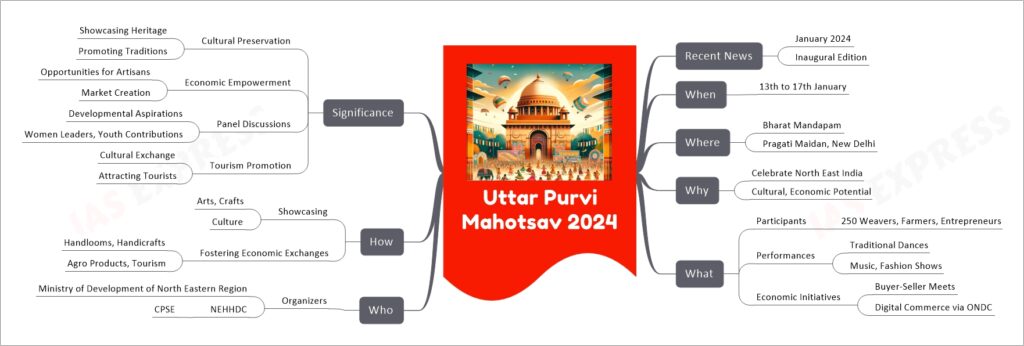
The Uttar Purvi Mahotsav 2024, scheduled from January 13th to 17th in New Delhi, is a significant cultural festival highlighting the rich heritage of Northeast India. Organized by the Ministry of Development of North Eastern Region and NEHHDC, it represents a vibrant amalgamation of traditional arts, dances, music, and fashion, focusing on showcasing the diverse cultural and economic potentials of the Northeast. Featuring 250 participants including weavers, farmers, and entrepreneurs, the festival aims to foster economic opportunities through buyer-seller meets and digital commerce initiatives. Panel discussions will address regional development and empowerment themes, while the festival as a whole serves as a platform for cultural preservation, economic empowerment, and tourism promotion, embodying the unity and evolving socio-economic landscape of Northeast India.

In simple terms, the NAM Summit is a gathering of nations that prefer not to align themselves with major power blocks like NATO or the former Soviet Union. Founded during the Cold War, its purpose was to give a voice to developing countries and maintain their independence in international affairs. The 19th NAM Summit in Uganda reflects the continued significance of this movement, with its focus on South-South cooperation and providing a platform for independent collaboration among nations. Representatives from across the world, including India’s External Affairs Minister, Dr. S Jaishankar, will discuss various global issues, with the outcomes impacting both the member states and the broader international community.

The ‘Navya Ayodhya’ project, initiated by the Yogi Government of Uttar Pradesh, is primarily focused on transforming Ayodhya into a major tourist destination. A significant component of this project is the Paying Guest Scheme, which involves local building owners providing accommodation to tourists, thereby generating additional income and enhancing the city’s hospitality tradition. The project also includes the development of a Greenfield Township, covering an area of 1438 acres, to create a pollution-free and well-facilitated environment for residents and visitors. While I couldn’t access specific details about the full provisions, objectives, or challenges of the project, its current focus seems to be on boosting tourism and cultural exchange in Ayodhya.
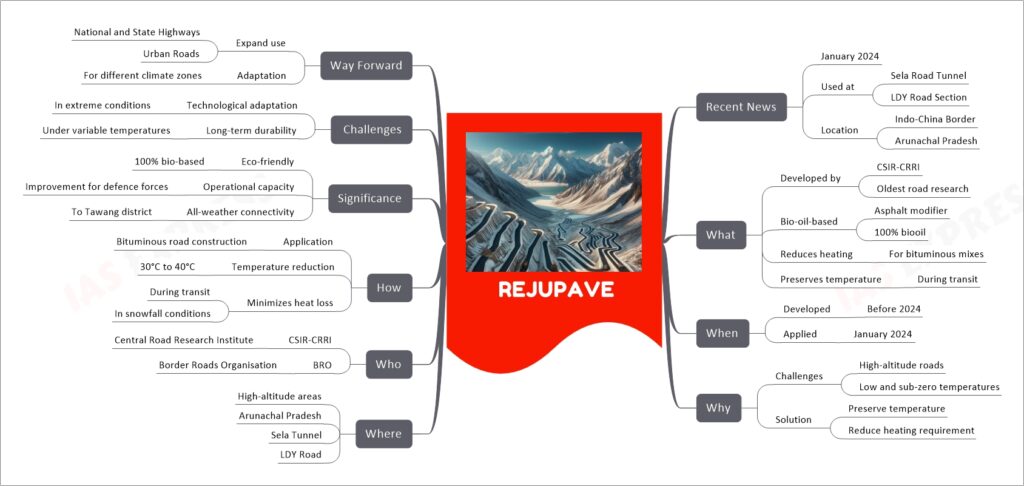
REJUPAVE is an indigenous technology developed by the CSIR-Central Road Research Institute (CSIR-CRRI), primarily used for constructing and maintaining bituminous roads in high-altitude areas, particularly under low and sub-zero temperature conditions. It is a bio-oil-based asphalt modifier that significantly reduces the heating requirement of bituminous mixes while preserving their temperature during transit. This eco-friendly technology has been successfully implemented by the Border Roads Organisation (BRO) at strategic locations like the Sela Road Tunnel and LDY Road Section near the Indo-China border in Arunachal Pradesh. The technology addresses major challenges in road construction in difficult terrains and contributes to the operational capacity improvement of defence forces and all-weather connectivity in remote regions.
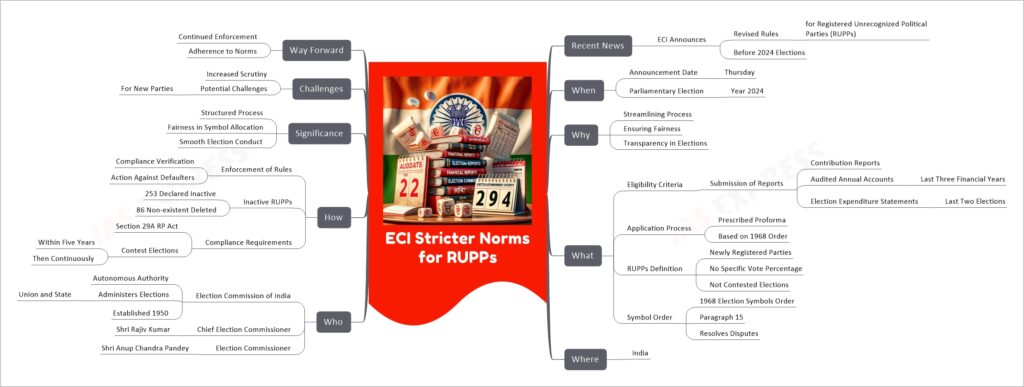
The Election Commission of India (ECI) has introduced stricter norms for the allotment of symbols to Registered Unrecognized Political Parties (RUPPs), particularly in the context of the upcoming 2024 Parliamentary elections. These revisions aim to streamline the symbol allocation process, emphasizing transparency and fairness. The new criteria require RUPPs to submit their contribution reports, audited annual accounts for the past three financial years, and election expenditure statements for their last two contested elections. Additionally, RUPPs, including newly registered parties or those that haven’t attained specific vote percentages, need to adhere to these regulations to qualify for common symbol allotment. The ECI’s move ensures a more structured process for election participation, while also holding parties accountable for compliance with established norms.
